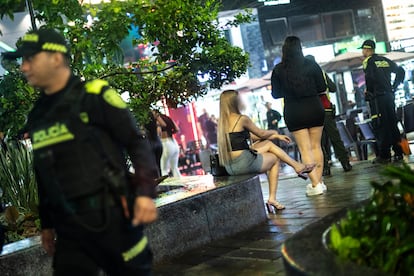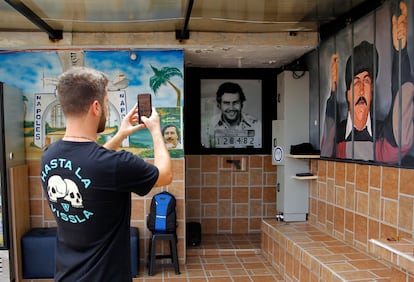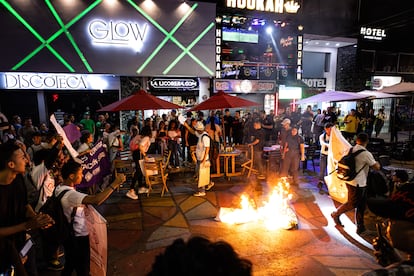
29 tourist deaths trigger alarm bells in Medellín
In 2024, there has been one death every 6 days in the Colombian city, compared to one every 10 days in 2023. At least half of those killed have been Americans
29 muertes de turistas encienden las alarmas en Medellín
Bogotá, 24 June 2024
On Thursday morning, Matthew Watson Croulet got into a cab in Medellín. He was disoriented, remembering nothing but the name of his hotel, according to the police report. The driver took him to the tourist neighborhood of El Poblado and dropped him off. When the 25-year-old American entered his hotel, the staff noted that he looked drugged. It was clear he was not well. Concerned, they called an ambulance. Watson, meanwhile, went up to his room where he was found dead at 9.25 am.
Watson is the latest tourist corpse to be discovered in Medellin in what is becoming a cumulative problem. Last year, there were 37 violent tourist deaths in Colombia’s second-largest city. That is an average of one every 10 days. So far in 2024, 359,000 tourists have visited the city, and there have already been 29 violent tourist deaths, which is more than one per week. If the pace continues, the year would close with 61.
 |
| Tourists at the Pablo Escobar museum in Medellin, ColombiaFREDY BUILES |
However, a pattern is emerging. On May 31, another U.S. citizen was found dead in a hotel in the tourist district of Laureles. Jaime Eduardo Cisneros, 54, was lying on a bed half-naked, rolled up in a sheet, with no signs of violence. The authorities have not yet determined the cause of death. They indicate that the man entered his room with a woman during the early hours of the morning. After a short time, she came out. He did not.
Tourists, drugs and prostitution
Carlos Calle heads up the Medellín District Attorney’s Office’ Tourism Observatory. His job is to generate reports on tourism activity in the city. He explains to EL PAÍS that the city closed 2023 with the highest rate of foreign visitors in its history: almost 1.5 million. “It was also the year in which the most foreigners met violent deaths,” he says. According to Calle, Medellín is safe for tourists. However, he says there is an increasingly frequent negative tourist profile. “The situations in which these foreign tourists are negatively affected are almost always related to drugs or prostitution,” he says.
The birthplace of Pablo Escobar, Medellín was once one of the most dangerous cities in the world. However, in recent years it has become a desirable tourist destination. Within Colombia, it has a reputation as the city of innovation, beauty, partying, and narcoculture. This has had both positive and negative consequences. In recent years, more and more foreigners have come to the capital with the aim of paying for sex, which is not a crime in Colombia, provided no minors are involved.
Although the Escobar era is over, Calle points out that the city is home to a large number of criminal gangs, which offer exactly what negative-profile tourists are looking for: drugs and prostitutes. According to Calle, many such travelers end up in dangerous situations, consuming high doses of narcotics in environments that can be unsafe. Some local criminals give them scopolamine. Also known as burundanga, this drug disorients and uncapacitates users. It can be slipped into drinks, snorted, or simply blown into the victim’s face. The victim is unlikely to have any recollection of the event and there could be fatal consequences.
Calle points out that, given the numbers of tourists who travel to Medellín every year, those who come seeking sex and drugs are relatively few, but they are a growing demographic. He adds that it is important they are aware of the law and keep their wits about them. “Number one, in Colombia the exploitation of minors is a crime. We will not tolerate that,” he says. “Number two, don’t accept drinks from a stranger in a bar. Don’t get into a stranger’s car. If you want to go with a girl, share the location or at least try to stay in contact with someone you know.”
Yiri Milena Amado, a former director of the Attorney General’s Office in Valle de Aburrá, the region in which Medellín is located, agrees. In March, she gave an interview to Semana, explaining that there was a common thread to the spate of tourist deaths in the city, namely “deadly cocktails.” The Prosecutor’s Office frequently found the deceased traveler had consumed a combination of drugs: “Cocaine, tusi and marijuana. Also, sexual enhancers, such as Viagra, and bottles of alcohol,” she said.
In plain sight
Last April, EL PAÍS traveled to Medellín to report on tourists and sexual exploitation. The testimonies of several sex workers and multiple visitors made it clear that drugs are ever-present in this context. Sitting in Lleras Park, where dozens of tourists come every night for sex, a prostitute introducing herself as Alexa Gómez explained that she needed drugs to sleep with clients. “It makes you happy, and everyone likes a smile,” she said. Another sex worker, who preferred to remain anonymous, said that her clients would consume a lot of drugs, and that she often encouraged the men to consume more as a way of avoiding having to have sex with them.

Sex workers in Parque Lleras, on March 6.CAMILO MORENO
Over the next half hour, Bob repeatedly asked the other two women about the whereabouts of their colleague and the drugs. Sex worker Yuliet, 24, explained that the American liked to get high: “He does too much cocaine and wants us to do it too. I don’t like it, it scares me. I prefer the tusi. But I still do cocaine when he asks me to do it.”
Sexual exploitation of minors
There are also foreigners who go to Medellín with the specific aim of sexually exploiting minors. On March 28, a 36-year-old U.S. citizen, Timothy Alan Livingston, was discovered by police in a hotel in El Poblado with two girls ages 12 and 13. According to Colombian law, sexual consent for minors under the age of 16 only exists if the person seeking sex is no more than three years older than the minor. Despite Timothy Alan Livingston’s age, the man was released shortly after his arrest and returned two days later to Florida. A Colombian judge, however, issued a warrant for his arrest in April, yet he remains at large in the U.S.
Less than a month later, U.S. police arrested an American pedophile, Stefan Andres Correa. The man had traveled 45 times in just two years to Colombia to abuse minors. During the investigation, the authorities found nine cell phones on which there was extensive evidence of his sexual abuse, including conversations with a Colombian pimp who allegedly hooked him up to underage girls in Medellín.
These two cases have shocked Medellín and prompted Mayor Federico Gutiérrez to launch an extensive prevention campaign. Over the past three months, the city has been filled with posters attempting to prevent the sexual exploitation of minors. “Don’t even try, it’s a crime,” they say.
These posters cover the walls of the city’s two airports. They are also seen in many hotels and restaurants. There are no official figures on how many minors have been sexually exploited in Medellín in 2024, but, last year, more than 320 victims of this crime were reported in the city, according to the NGO Valientes Colombia.



No comments:
Post a Comment